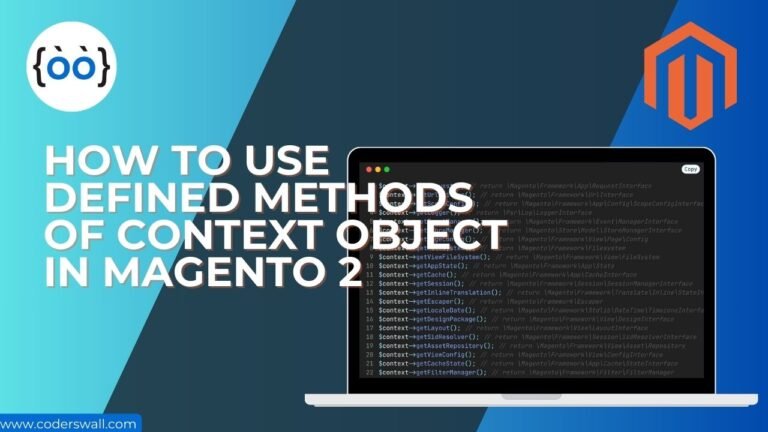In this article, we are going to know about the Context Object in Magento 2 and how to use the defined methods of the Context Object in your Magento 2 module.
1. What is a Context Object in Magento 2?
A Context Object is an object which has several constructor dependencies and getters of other objects. It works like a container for other objects.
A context object doesn’t have any functionality of its own, it’s just a container for other objects.
2. Types of Context Objects
There are different context objects used for different parts of the Magento 2.
2.1 Context Object in a Magento 2 Block
In a Magento 2 block, the class of the context object is \Magento\Framework\View\Element\Template\Context.
The constructor of a Magento block class looks like this.
public function __construct(
\Magento\Framework\View\Element\Template\Context $context,
array $data = []
) {
parent::__construct($context, $data);
}2.2 Context Object in a Magento 2 Helper
In a Magento 2 helper, the class of the context object is \Magento\Framework\App\Helper\Context.
The constructor of a Magento helper class looks like this.
public function __construct(
\Magento\Framework\App\Helper\Context $context
) {
parent::__construct($context);
}2.3 Context Object in a Magento 2 Model
In a Magento 2 model, the class of the context object is \Magento\Framework\Model\Context.
This context object can be used in the constructor of a Magento model class like this, of course, along with other required objects and dependencies.
public function __construct(
\Magento\Framework\Model\Context $context
) {
$this->context = $context;
}2.4 Context Object in a Magento 2 Controller
In a Magento 2 controller, the class of the context object is \Magento\Framework\App\Action\Context.
This context object can be used in the constructor of a Magento controller action class like this, of course, along with other required objects and dependencies.
public function __construct(
\Magento\Framework\View\Result\PageFactory $resultPageFactory,
\Magento\Framework\App\Action\Context $context
){
$this->resultPageFactory = $resultPageFactory;
$this->context = $context;
}
3. How to use the Defined Methods from the Context Object
Since the context object work as a container for other objects, it can be used to access the other objects and their methods.
For example, if you need to fetch store configurations in your block, by most common practice of DI (Dependency Injection), you will inject the \Magento\Framework\App\Config\ScopeConfigInterface class in the constructor like this,
public function __construct(
\Magento\Framework\View\Element\Template\Context $context,
\Magento\Framework\App\Config\ScopeConfigInterface $scopeConfig,
array $data = []
) {
$this->_scopeConfig = $scopeConfig;
parent::__construct($context, $data);
}Although, this code will work, but it’s not correct and not necessary to inject this class in the constructor, because, the $context object already contains the object of the \Magento\Framework\App\Config\ScopeConfigInterface class.
While compiling the above code using bin/magento setup:di:compiler command, sometimes this type of error occurs, “Incorrect dependency in class“.
So, instead of injecting the class to the constructor, the correct way is to directly use the defined methods of the context object to fetch the objects of the contained classes. The correct way to call the\Magento\Framework\App\Config\ScopeConfigInterface class in the above example is this,
public function __construct(
\Magento\Framework\View\Element\Template\Context $context,
array $data = []
) {
$this->_scopeConfig = $context->getScopeConfig();
parent::__construct($context, $data);
}4. List of Methods from Context Object
4.1 Methods from Context Object in Block
$context->getRequest(); // return \Magento\Framework\App\RequestInterface
$context->getUrlBuilder(); // return \Magento\Framework\UrlInterface
$context->getScopeConfig(); // return \Magento\Framework\App\Config\ScopeConfigInterface
$context->getLogger(); // return \Psr\Log\LoggerInterface
$context->getEventManager(); // return \Magento\Framework\Event\ManagerInterface
$context->getStoreManager(); // return \Magento\Store\Model\StoreManagerInterface
$context->getPageConfig(); // return \Magento\Framework\View\Page\Config
$context->getFilesystem(); // return \Magento\Framework\Filesystem
$context->getViewFileSystem(); // return \Magento\Framework\View\FileSystem
$context->getAppState(); // return \Magento\Framework\App\State
$context->getCache(); // return \Magento\Framework\App\CacheInterface
$context->getSession(); // return \Magento\Framework\Session\SessionManagerInterface
$context->getInlineTranslation(); // return \Magento\Framework\Translate\Inline\StateInterface
$context->getEscaper(); // return \Magento\Framework\Escaper
$context->getLocaleDate(); // return \Magento\Framework\Stdlib\DateTime\TimezoneInterface
$context->getDesignPackage(); // return \Magento\Framework\View\DesignInterface
$context->getLayout(); // return \Magento\Framework\View\LayoutInterface
$context->getSidResolver(); // return \Magento\Framework\Session\SidResolverInterface
$context->getAssetRepository(); // return \Magento\Framework\View\Asset\Repository
$context->getViewConfig(); // return \Magento\Framework\View\ConfigInterface
$context->getCacheState(); // return \Magento\Framework\App\Cache\StateInterface
$context->getFilterManager(); // return \Magento\Framework\Filter\FilterManager4.2 Methods from Context Object in Helper
$context->getRequest(); // return \Magento\Framework\App\RequestInterface
$context->getUrlBuilder(); // return \Magento\Framework\UrlInterface
$context->getScopeConfig(); // return \Magento\Framework\App\Config\ScopeConfigInterface
$context->getLogger(); // return \Psr\Log\LoggerInterface
$context->getEventManager(); // return \Magento\Framework\Event\ManagerInterface
$context->getModuleManager(); // return \Magento\Framework\Module\Manager
$context->getCacheConfig(); // return \Magento\Framework\Cache\ConfigInterface
$context->getHttpHeader(); // return \Magento\Framework\HTTP\Header
$context->getRemoteAddress(); // return \Magento\Framework\HTTP\PhpEnvironment\RemoteAddress
$context->getUrlEncoder(); // return \Magento\Framework\Url\EncoderInterface
$context->getUrlDecoder(); // return \Magento\Framework\Url\DecoderInterface4.3 Methods from Context Object in Model
$context->getLogger(); // return \Psr\Log\LoggerInterface
$context->getCacheManager(); // return \Magento\Framework\App\CacheInterface
$context->getEventDispatcher(); // return \Magento\Framework\Event\ManagerInterface
$context->getAppState(); // return \Magento\Framework\App\State
$context->getLogger(); // return \Psr\Log\LoggerInterface4.4 Methods from Context Object in Controller
$context->getActionFlag(); // return \Magento\Framework\App\ActionFlag
$context->getEventManager(); // return \Magento\Framework\Event\ManagerInterface
$context->getObjectManager(); // return \Magento\Framework\ObjectManagerInterface
$context->getRedirect(); // return \Magento\Framework\App\Response\RedirectInterface
$context->getRequest(); // return \Magento\Framework\App\RequestInterface
$context->getResponse(); // return \Magento\Framework\App\ResponseInterface
$context->getUrl(); // return \Magento\Framework\UrlInterface
$context->getMessageManager(); // return \Magento\Framework\Message\ManagerInterface
$context->getResultRedirectFactory(); // return \Magento\Framework\Controller\Result\RedirectFactory
$context->getResultFactory(); // return \Magento\Framework\Controller\ResultFactoryI hope this article is helpful for you. For any query, leave a comment.




Useful content 👌